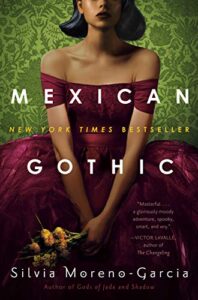( Bookshop.org | Amazon.com )
Mexican Gothic by Silvia Moreno-Garcia
Del Rey, 2020
ISBN: 9780525620785
Available: Hardcover, Paperback, Audiobook, Kindle
In 1950’s Mexico, Noemi, a flirtatious, intelligent fashionista, decides her cousin Catalina has been out of touch for too long. When Noemi receives a disturbing letter from Catalina suggesting that she might want to escape from her new marriage, Noemi packs her gorgeous wardrobe and heads to isolated High Place, the ancestral home of the English Doyles, to investigate.
Ever the realist, skeptical of her cousin’s fairytale princess notions about marriage, Noemi immediately distrusts her suave brother-in-law. She soon realizes that he is evil, and so is his menacing house that has wallpaper “slippery, like a strained muscle” and walls like “sickly organs” with “veins and arteries clogged with secret excesses.” Something is not right at High Place, and Noemi starts to feel its curse invading her mind and body, slowly but surely, just as it has infected her cousin.
What begins as a poetic, gothic fairytale, becomes a wild blend of fantasy, horror, and science-fiction in Mexican Gothic by Silvia Moreno-Garcia. The Doyle men and women have preserved their family line by choosing between “fit and unfit people.” The men wield their power by practicing eugenics through a weird and totally terrifying combination of sexual abuse, drugs, intimidation, and psychological control. The house has an actual heartbeat that is pulsing with mold, fungus and rot, and the creepy family patriarch, an ugly man full of secrets and disgusting tumors, sores, and black bile, is directing and insuring the family’s future from his deathbed. Murders have occurred at High Place, and strange epidemics have killed droves of workers in the family’s silver mine. Once Noemi has the facts, she knows she must fight and use her wits to survive and save the people she cares about before the evil overcomes them and traps them in a living hell forever.
Although the book seems set in a period later than the 50’s in terms Noemi’s language and sensibility, it still is, in more than one sense, a horror story that reflects the historically violent subjugation of women used as breeders in families and cultures obsessed with lineage and legacy. Religion, status, and seclusion frequently became barriers to freedom for these women by preventing them from making choices about the direction of their own lives. The women of Mexican Gothic cope with horrible suffering and mirror the superhuman strength it took for real women to endure, and sometimes find rare opportunities to escape, the nightmarish situations forced on their gender. Highly Recommended.
Contains: gore, sexual situations, profanity, incest, body horror
Reviewed by Nova Hadley
Editor’s note: Mexican Gothic is a nominee on the final ballot for the 2020 Bram Stoker Award for Superior Achievement in a Novel.






Follow Us!